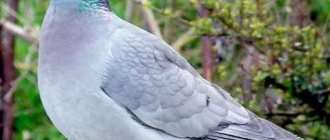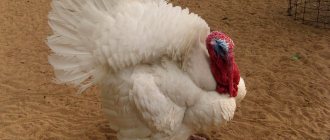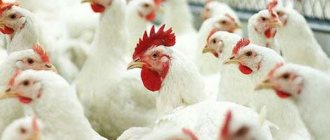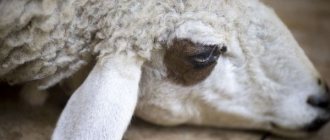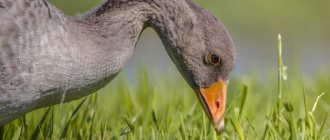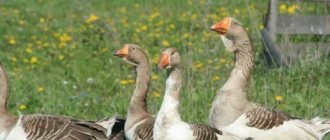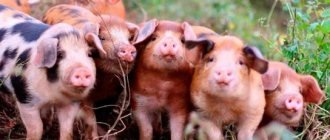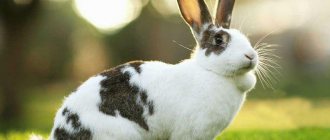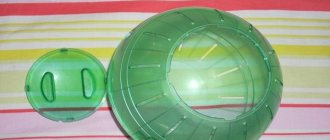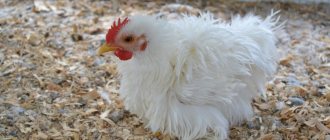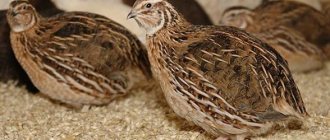Classification of chickens
Birds are classified according to different characteristics. In appearance they are:
- large;
- average;
- dwarf;
- decorative.
Taking into account plumage, the following types are distinguished:
- ordinary;
- hairy legs;
- bare-necked;
- crested.
Birds also differ in color. Males have more saturated colors, a long tail and neck. They are characterized by a clearly defined ridge.
According to their purpose, birds are divided into the following groups:
- egg;
- meat;
- meat and egg
Decorative breeds
These are the most beautiful individuals that have many features. They are grown for decorative purposes.
Bantams
These are Japanese dwarf birds. They are characterized by high activity and ease of care. Birds are black, brown, and speckled in color. They can hardly stand the cold. The bird produces 85-100 eggs.
Seabright
These are graceful dwarf chickens that are characterized by a trusting disposition. They can fly and easily adapt to any conditions. The meat has excellent taste. A laying hen produces 100 eggs.
Padua
This is a rare meat-egg breed. It is characterized by a long thick crest that forms a cap on the head. However, the earrings and comb are missing. Birds are characterized by a blue beak. Egg production – 120 pieces.
White-crested Dutch blacks
A white crest is visible on the head, which contrasts with the dark plumage. Roosters weigh 2.5 kilograms, hens weigh a little less - 2. Laying hens produce 100-140 eggs.
Curly
This is an ornamental meat-egg variety that has raised feathers. This gives the bird a shaggy and disheveled appearance. The paws are also covered with feathers. Birds are characterized by a friendly nature. The annual egg production reaches 120 eggs.
Shabo
This is a meat-eating Japanese variety characterized by short legs, long wings and an erect tail. The chicken is considered friendly and unpretentious. Egg production parameters reach 150 pieces.
Decorative chickens
The tradition of keeping ornamental chickens has been around for a long time. In rich houses, and even in palaces, they were kept in cages, like other decorative birds - parrots, canaries.
Given their small size and sedentary behavior, ornamental chickens did not experience the inconvenience of living in a cage.
Popular breeds of ornamental birds:
Bantams - experts include a large number of subspecies of different breeds in dwarf form to this breed. Usually the weight of bantams is no more than 1 kg with the original color. The plumage looks like a Chinese silk scarf.- Shabot is a bird bred exclusively for decorative purposes. The color can be of different colors, body weight is about 500 grams. The plumage is delicate, like a fluffy downy scarf.
- Pavlovskaya is a small motley bird, weighing up to 1.5 kg. The content is difficult, a mandatory walk is required.
- Seabright - chickens of this breed were bred in England, and were very much in demand by English gentlemen, who even created clubs for Seabright lovers. The bird has a contrasting, pronounced pattern, black and white or golden. The colors of both sexes are the same. Chickens belong to the dwarf category, their weight does not exceed 600 grams.
Fighting cocks
This is an unusual category of birds that has a cocky character. There are many fighting species.
Azil
This is the oldest breed, which includes many species. The weight of roosters reaches 2.5 kilograms, and hens - 2. Egg production parameters - 120 pieces.
Old English
Representatives of the breed are characterized by a bold and proud character. They are highly trainable. A rooster weighs about 800 grams, a chicken – 700 grams.
Belgian
This is an old variety that was bred in the seventeenth century. Roosters weigh about 5 kilograms, chickens - 4 kilograms.
Moscow view
This species is characterized by 2 directions - meat and fighting. Roosters reach 6 kilograms, hens weigh 3 kilograms. Egg production – 120 pieces.
Breed diversity
Any chickens can be kept for economic purposes, but not all birds are capable of showing high egg production or rapid weight gain. Some varieties have rare external characteristics or other qualities that are of interest to breeders. Therefore, domestic chickens are usually divided according to areas of use into the following large groups:
Egg
They are characterized by high productivity - females of the most successful varieties, when kept in optimal conditions, are able to lay eggs every day, laying up to 300 eggs annually. The bird does not gain impressive weight, but reaches sexual maturity early. The meat of most of these breeds does not have high taste, although there are exceptions. For example, “Shandalar” and “Chernyakhovskaya” chickens, which have quite decent egg production, are kept on farms to produce meat products that are considered “elite” and highly valued by gourmets.
Chickens do not gain much weight, but are distinguished by early puberty and high egg production
Currently, for the mass production of eggs, not only purebred chickens are used (“Leggorns”, “Loman Browns”, “New Hampshires”, “Russian Whites”, “Rhode Islands”, “Bengals”, etc.), but also highly specialized crosses (“Dominant”, “Rhodonit 3”, “Tetra”, “Hisex”, etc.), capable of showing maximum productivity with minimal costs for food and care. Laying hens that produce “colored” (“Easter”) eggs are especially valued. It is believed that such products have a high content of useful substances and even have healing properties.
Meat
Representatives of this group are large birds with a dense build, strong bones and large body weight (adult chickens up to 4.5 kg, roosters up to 5 kg). Egg production is usually low, but females are usually good brood hens and caring mothers. Chicks, especially those crosses bred in recent decades, can reach a slaughter weight of 2.5-3 kg already at the age of 6-7 weeks, which makes their maintenance extremely profitable. At the same time, the taste characteristics of meat products deserve the best reviews from consumers.
Meat poultry is characterized by intensive growth and rapid gain of live weight
Despite the wide distribution of new interbreed hybrids, many poultry farmers prefer to breed purebred birds of this direction (Bram, Cochin, Cornish, Langshanov, etc.). This approach allows you not only to provide your family with high-quality meat, but also to make good money selling purebred chickens and hatching eggs.
Meat and egg
The most common type of domestic chicken in private households, also called universal or general-use. Despite the very different external characteristics, birds of this group are united by unpretentiousness in food and maintenance, as well as a fairly high egg production and the ability to produce meat products of decent quality.
All-rounder chickens are in demand by many poultry lovers, as they are unpretentious in maintenance and provide high productivity in meat and eggs.
Breeding poultry of most pure breeds is not a problem, since females have a developed maternal instinct, and young animals are characterized by high hatchability and survival rates. Getting parental “families” is also not that difficult. Many poultry farms and private owners sell hatching eggs or day-old chicks of popular varieties. However, according to experienced poultry farmers, in most cases, for birds that are expensive and relatively rare on the domestic market, you have to turn to foreign suppliers, since Russian breeders often sell material that does not meet breed standards.
Holocytic
The bird is valued for the ability of males to sing long, loudly and beautifully. In our country, “Yurlovsky vocal” roosters are famous, but this is not the only variety that is bred because of its “vocal” abilities. The most famous breeds of this group are “Drenitsa”, “Bergskaya volosistaya”, “Denizli”, “Ayam-ketava” and some others.
The voices of roosters have different timbres: from bass to falsetto, singing lasts on average 4-8 seconds, some record-breaking individuals are able to perform “vocals” for 12-16 seconds
Fighting
The purpose of breeding these breeds is to obtain roosters intended for participation in fights. This kind of fun has been extremely popular in many countries since ancient times. Around the middle of the 19th century, in most European countries (including Russia), this entertainment was officially prohibited, but not so much because of the cruelty of the spectacle, but because it was accompanied by betting games, which often resulted in losses. huge fortunes. However, in Cuba, in certain regions of France and some Asian countries, cockfighting is still legalized today.
Roosters of fighting varieties can be both large and small
Males must have powerful muscles, strong legs with well-developed spurs, a strong beak with a curved end, long sharp claws, short plumage adjacent to the body and a small crest. Of course, one of the main parameters is the presence of a “masculine” character. Roosters are specially selected and trained to enhance their natural aggressiveness. Such breeds as “Moscow Fighting Dog”, “Shamo”, “Azil”, “Yamato”, “Tuzo”, “Lari”, “Kulangi”, “Lutticher”, as well as English, Belgian, Sumatran and other fighting breeds are widely known in the world. chickens.
Decorative
The bird is bred solely for its appearance. This group includes chickens “Chinese Silk”, “Bantamka”, “Paduan”, “Seabright” and many others, as well as all dwarf varieties of known breeds.
Decorative varieties are distinguished by interesting colors, the presence of crests, fluffy collars and other spectacular plumage features
Various common chickens for household purposes are described in detail in articles posted on our website. Next, we invite you to get acquainted with the descriptions and photographs of some of the “champions” of the chicken world, and learn about why they are interesting for breeders.
Meat breeds
Such birds are raised to produce tasty dietary meat. Therefore, they are very popular among farmers. Representatives of such breeds are characterized by a powerful body and loose feathers. They have a phlegmatic character and tasty meat.
Corniche
Initially, the breed was a fighting breed. However, later they began to grow it as meat. A chicken lays 90-130 eggs per year. The weight of females reaches 3 kilograms, males - 4. The meat has a good taste.
Brahma
This is a powerful breed with a calm nature. She is unpretentious in care. Raising chickens is easy. Feathered legs are considered a special feature of birds. They lay 160 eggs per year. The chicken weighs 4 kilograms, the rooster - about 5.
Chickens are characterized by late maturation. They have many types. Birds have tasty meat, but it is a little rough.
Cochin
This Chinese variety is characterized by its impressive size. It is characterized by a strong body, a wide chest and a small head with a crest resembling a leaf. A chicken weighs 4 kilograms, a rooster weighs 5. The bird produces no more than 120 eggs per year.
See also
History of the origin and breed of black chickens with black meat, maintenance rulesRead
These chickens are easy to care for. They are considered hardy and have an excellent appetite. Raising birds helps produce a lot of tasty meat.
Faverolles
This species of birds was bred in France. Individuals are characterized by a massive body, low paws and a small tail. The weight of the birds does not exceed 3 kilograms. An indisputable advantage is the ease of plucking the carcass.
Birds become strongly attached to their owner. They have a friendly character and powerful build. The meat has a pleasant taste. Representatives of the breed have a tendency to be overweight, so it is recommended to control their diet.
La Flèche
Chicken weight – 3-4 kilograms. It is characterized by gray feathers with a green tint. A distinctive feature is the V-shaped ridge.
Universal breeds
If we talk about private backyards and small farms, then, of course, birds of a universal nature are more popular.
The Jersey giant certainly lives up to its name. At exhibitions there are roosters weighing up to 10 kg. A real decoration for a household yard. The black chicken is about 1.5 kg smaller, but has good egg-laying qualities. Gives up to 180 eggs. She remains an excellent mother and the breed can be bred without an incubator.
Orpington is one of the best for home breeding. Good egg production from 160 to 180 eggs, excellent brooding instinct, phlegmatic character and many decorative subspecies. Outwardly, it resembles a fluffy cube slowly walking around the yard.
The young domestic Hercules breed combines early ripeness with good egg production and high-quality meat. A calm, good-natured bird suitable for walking on small farms. Unfortunately, when breeding at home, the bird needs to update its genetics after 3-4 years.
Maran lays truly golden eggs, weighing up to 85 grams. At exhibitions they present eggs up to 100 g, which is already difficult to imagine as chicken. It’s true that egg production is not the greatest, but it is a large carcass with exquisite taste. This chicken is a real decoration of the yard.
Adler silver, despite its southern origin, tolerates Russian winters well. An unpretentious bird kept in a yard, it can please for quite a long time with its ability to lay eggs. This layer retains its quality for up to 4 years, and often longer. But if they are kept for fattening, then by the age of one year the males will already have reached 4 kg of weight, and the female’s carcass will be about 2.5 kg. The meat has good taste.
Amrox is a business German breed. Has very strong stable genetics. It did not spread significantly on its own, but as the ancestor of many crosses it is very popular. Therefore, breeders carefully maintain this breed in pure lines.
Pushkin chicken selection is popular due to its stability. In all respects it corresponds to modern characteristics of meat and egg products. They tolerate being kept in northern regions and are not picky about nutritional conditions. The carcass has a good presentation.
Another calm, businesslike German breed is the Bielefelder. The chicken will not fight even over food; they feed busily, taking turns. At the same time, they have good commercial indicators. They gain weight quickly, begin laying eggs fairly early, and have a low incidence rate. A worthy bird for an idealistic farm.
The broiler chicken breed is well represented by the “fox chicken”, which received this name for its color. Sometimes Foxy Chick is also called Red Broiler. The speed of weight gain and ease of maintenance and almost 100% survival rate of chickens makes keeping these birds very economically profitable. In addition, she has decent egg production - 260-300 eggs is quite an achievable result for her.
The Moscow black bird has gained popularity among farmers and summer residents of central Russia. Well adapted to the conditions of the middle zone, unpretentious in maintenance, feed and with good genetics, the bird is a worthy option for small farms.
American by birth, Plymouth Rock has all the good qualities. Egg production 160-190 eggs. Eggs weigh an average of 58 g and are laid from 6 months. The weight of a rooster carcass is about 4 kg, a chicken is 1 kg less. Chick survival rate is 96%. The hatching instinct is good.
An interesting breed of Goloshka. Popular in Austria, Hungary and southern Russia. A characteristic feature is the absence of feathering on the neck. The meat tastes like turkey, only more tender and juicier. Egg production is about 180 eggs. Survival rate of young animals is 94%. They are not whimsical in nutrition and maintenance.
The Master Gray is a universal cross-breeding bird. One of the most mysterious crosses in origin. The selection belongs to the Hubbard company and its origin is not disclosed. At the same time, it has excellent egg production qualities - up to 300 eggs and at the same time has tender, tasty meat. Although it is impossible to breed it yourself, the breed is still very popular among homesteads. Especially for seasonal maintenance. After all, she begins to lay eggs already at 4 months.
Meat-egg birds
These are versatile varieties that produce a lot of eggs and can be used as sources of eggs or meat.
Rhode Island
The birds are characterized by a reddish tint and a green tail. Birds begin to lay eggs at 7 months. Productivity – 220 pieces. An adult male weighs 3.9 kilograms, a female – 2.9.
New Hampshire
These chickens are considered a variety of the Rhode Island breed. The livestock is characterized by excellent survival rate. Chickens begin to lay eggs starting from six months and produce 190 eggs. The weight of the hen is 2.6 kilograms, the rooster is 3.3.
Plymouth Rock
This variety is characterized by an attractive exterior, large volume of eggs and excellent taste of meat. The bird is large in size. The rooster weighs 6 kilograms, the chicken - 3.6. A laying hen produces 180 eggs.
Jersey giant
Such individuals are characterized by large sizes. With proper care, a rooster weighs 7-8 kilograms. Laying hens produce 180 eggs per year and weigh 4.5-5 kilograms.
Legbar
This variety is chosen by farmers who like unusual chickens. Legbar produces eggs with the original blue shell. Egg production parameters – 200-210 pieces. Males weigh up to 3.4 kilograms, females - up to 2.7.
Russian Crested
This is a common species that is characterized by a good immune system and endurance. The weight of chickens is 2.2 kilograms, roosters are 3.5. Productivity exceeds 160 eggs.
Foxy Chick
This Hungarian variety is considered productive. The weight of a chicken reaches 4 kilograms, and a rooster – 7. The meat has a delicate taste and juiciness. It contains little fat. A laying hen can lay up to 250 eggs.
Wyandotte
This breed appeared in North America in the nineteenth century. Today, more than 15 species of such birds are known, which differ in color. Egg production parameters – 170 pieces. Hens weigh up to 2.5 kilograms, roosters - 3.5.
Australorp
This ancient breed originated in Australia. Chickens lay 150-180 eggs. Good productivity continues in winter. The weight of roosters is 4 kilograms, chickens are 2.9.
Maran
These birds are characterized by an elongated body and dense plumage. They produce approximately 150 eggs. Laying hens reach a weight of 3 kilograms, the weight of roosters exceeds 4 kilograms. The advantages are resistance to disease and unpretentiousness.
Bress Galskaya
The main advantage of birds is their rapid maturation. Bress Gali chickens grow rapidly and gain body weight. The breed is also characterized by high egg production. Laying hens produce up to 200 eggs per year.
Galan
This is a Russian species of bird that has become less common. Chickens give 200 eggs. The weight of roosters reaches 4 kilograms, chickens weigh up to 3 kilograms. Individuals have black feathers with a green tint.
Hungarian giant
This variety of chicken is one of the ten best European breeds in terms of productivity. Chickens produce up to 250 eggs. The weight of males reaches 7 kilograms. The chickens weigh 4 kilograms.
Borkovskaya barvistaya
These birds are characterized by a powerful build and a small head. Chickens lay eggs from 4.5-5 months and produce up to 265 eggs. After 2 years, productivity decreases, which is worth taking into account to maintain the productivity of the flock.
The breed is characterized by high-quality meat. The bird is able to adapt to any weather conditions and has an easy-going nature. It is easy to breed at home. An indisputable advantage is the pronounced brooding instinct.
Tetra
Features of the birds are a small head, a scarlet comb and a short neck. The hybrid has good productivity parameters. They produce up to 300 eggs per year, weighing 60-65 grams.
These chickens are characterized by high-quality eggs and meat. They have excellent immunity and good survival rate of offspring. At the same time, birds consume a lot of feed during development.
Chicken vaccination
This applies to the moment when we take chickens from large farms or poultry farms. A vaccination passport must be provided upon purchase. What diseases are prevented by vaccination: Newcastle disease - pseudoplague, Gambino, Parnassus, infectious bronchitis. This is a minimum list.
Vaccination is carried out for chickens from one day to two months of age. If you buy pullets at the age of 4 - 5 months, then all these vaccinations should already be done. This is a mandatory event at poultry farms, because mass infection and death of birds cannot be allowed there.
When buying from a private person, you also need to ask about all this, but here everything depends on the honesty of the owner or breeder. That’s why you need to get as much information as possible about the seller and find out his reputation. The death of a bird from the onset of infectious infection occurs quickly; if in the evening the chicken was cheerful, then in the morning it may already be a corpse. Until you understand what’s going on, you can lose your entire livestock.
Egg breeds
These breeds of chickens are raised for the purpose of producing eggs. Today there are many varieties that are very popular among farmers.
Leghorn
This variety originated in Italy. Laying hens produce 200-250 eggs. Roosters weigh up to 3 kilograms, chickens - up to 2.5. Birds are characterized by a small body, a wide back and a round chest. The traditional option is white feathers.
See also
Description and rules for keeping chickens of the Aurora breedRead
Russian white
They are characterized by a white tint of feathers. Birds have a wide and elongated body, developed wings, and a thick neck. Laying hens produce 200-230 eggs per year. Females weigh 1.8 kilograms, males - 2.5.
Italian partridge
This is one of the first egg-laying birds. Excellent genetic characteristics provide excellent egg production parameters.
The bird has good survival rate and pronounced adaptive abilities. A rooster weighs 2.5 kilograms, a chicken - 1.5. Egg production parameters – 190-250.
Pushkinskaya
The birds are characterized by an elongated head and a typical variegated color. The powerful back is complemented by long wings. They lay about 220 eggs. The chicken weighs 2 kilograms, the rooster - 3.
Loman Brown
This is one of the most common egg breeds. The birds are unpretentious, but produce a lot of eggs. This figure reaches 310-320 pieces. Roosters weigh approximately 3 kilograms, chickens - 2.2.
Czech gold
This breed has an unusual color, which is why it is considered decorative. In addition, it has excellent egg production. Hens begin to lay eggs at 5-6 months. Annual egg production – 180 pieces.
Goloshka
It is not difficult to distinguish these chickens. A typical feature is the absence of feathers on the crop and neck. There is a red feather cap on the back of the head. In a year, a chicken produces no more than 130-160 eggs.
The most egg-laying bird species
At what age chickens will breed directly depends on the breed characteristics. So, for example, Leghorn, which is the progenitor of almost all egg-bearing breeds, lays eggs for the first time at 5 months, its average annual egg production is 300-320 eggs. It is not recommended to keep it at home due to its low stress resistance. Representatives are often subjected to noise hysteria, as a result of which they stop producing eggs for quite a long period of time.
Over the course of the entire year, the dominant can lay 300-320 eggs, the average weight of which is about 70 g. This is a rather picky bird in keeping and feeding. To improve the quality of eggs, protein must be present in her diet. Laying hens of the Loman Brown breed begin laying eggs at 4 months. Chickens do not require special housing conditions, but the flock should be periodically updated and culled.
White Russian chickens lay eggs for the first time at the age of 5.5 months. The average per year is 300 eggs, weighing 50 g each. Bred on the basis of Leghorn and outbred representatives. They have excellent immunity, are stress-resistant, and not picky about feeding. Orpingtons do not lay many eggs, but their indicators constantly remain at the same level. In the first year you can get about 180 pieces.
Chickens of the Hisex breed are quite popular due to their egg-laying qualities, but they are quite finicky in their maintenance. Pullets cannot tolerate drafts and are not resistant to stressful situations. Broilers, although they grow very quickly, are not used as egg producers. Their first clutch occurs at the age of 7-8 months.
Earlier clutches can only be observed in representatives of artificial breeding. Stimulating the onset of early egg laying in ordinary breeds is strictly prohibited. When a chicken lays eggs ahead of schedule, it can cause irreparable harm to the body and even lead to death. The color of the eggs will depend on the color of the chicken's plumage, for example, red chickens will lay brown eggs, while white chickens will have white or cream-colored eggs.
Chicken crosses
Today, modern bird hybrids are often used in poultry farming. Bird crosses are highly productive and have excellent early maturity.
Dominant
This is a popular meat-eating breed, which is characterized by a strong body and lush plumage. The dominant has a bright color and is unpretentious. Roosters weigh 3 kilograms, laying hens - 2.5. Egg production parameters reach 300 pieces.
Super Nick
This cross has unremarkable external data. It is characterized by dense white feathers and a compact triangular body. The weight of a rooster is about 2 kilograms, a chicken weighs 1.6. A characteristic feature is considered to be high egg production. Laying hens are capable of producing 350 eggs per year.
Red Kuban
This is a large egg breed. The birds are characterized by a small head and a large leaf-shaped comb. Dense red or red feathers are standard for the bird. The tail and wings have gray or black feathers. In unfavorable conditions, the bird produces at least 250 eggs per year. If the recommendations are strictly followed, this parameter can be increased to 340 pieces.
Rare and expensive varieties
These breeds are rare, due to their price. The uniqueness of chickens is due to the fact that they are on the verge of extinction. This is due to low productivity, difficulties in care and whimsicality.
Ameraucana
This is a rare breed of chicken that produces blue eggs and has delicious meat. Birds are active and need to be kept isolated. They are characterized by high egg production, which is 200 pieces.
Andalusian
This exotic breed of chicken is considered a meat breed. Since the birds are rare, they are raised only for ornamental purposes. The weight of a rooster is 2.5 kilograms, a chicken is 2. The annual parameters of egg production are 180 pieces.
Uheiliyuy
This unique breed was bred in China. It is black in color, including the comb. The weight of a rooster does not exceed 2 kilograms, a chicken - 1.8. The eggs have an original green shell and a unique composition.
Sicilian Buttercup
The breed combines excellent decorative characteristics and an aggressive character. A distinctive feature is the red comb, which resembles a bowl with teeth. Roosters weigh 2.5 kilograms, chickens - 2. They lay up to 150 eggs per year.
Features of keeping large chickens
The largest chickens are often low maintenance. But the poultry farmer needs to take into account some features associated with breeding heavyweights:
- The chicken coop should be clean. It is necessary to regularly clean the poultry house - this will ensure good health for the birds and protect them from various diseases.
- Large birds need space, this should be taken into account when preparing the chicken coop before breeding birds. It is advisable for birds to go out for a walk. An aviary with 1-2 birds per 1 square meter will be comfortable for animals.
- Due attention is paid to ventilation. Bird excrement releases ammonia, which accumulates on the floor and has a negative impact on the health of the animals.
- When building a poultry house, it is important to take into account the size of the birds. Animals will not be able to fly over the fence or jump. In accordance with this, nests and perches are not placed high - hens should have free access to them. As a last resort, the poultry farmer can build a ramp.
- Due to the fact that females are prone to frequently crushing eggs or throwing them out of nests, supervision is necessary for them. This will avoid the loss of unborn offspring.
- It is recommended to cover the floor in the poultry house with sawdust, straw, grass or other soft materials. Heavy weight often causes falls, even from low heights, which can lead to injury.
- Bird combs are very sensitive and at temperatures of 0 degrees and below they can be damaged. During the cold season, it is advisable to move birds to a warm room or lubricate their combs with oil.
There are numerous large breeds of chickens in the world. All of them are united by large dimensions, unique appearance, high egg and meat productivity. Most poultry farmers are engaged in breeding large birds for the further sale of eggs and animal carcasses - this helps to obtain excellent benefits.
0
0
Copy link
Selecting laying hens based on productivity
To choose domestic chickens, you should focus on the productivity of the breed. Birds come in meat and egg varieties. Birds of the egg direction must have the required egg production parameters. These include the Leghorn breed, whose representatives produce up to 300 eggs per year.
Italy is considered the birthplace of birds. Breeders have been trying for many years to develop new breeds based on it, but they have not been able to increase the rate.
What breed of chicken is best to avoid?
Almost all modern chickens are capable of laying eggs. However, the question is their number and the need to care for the birds. Experts advise excluding the breeding of purebred Minorok chickens. They are characterized by excellent egg production. Adults have a slender, elongated body and a small head, which is decorated with a red comb.
However, it is worth considering that the breed was created in Spain, and therefore it is considered heat-loving. In the south, such chickens can still be raised. At the same time, in the Moscow region and especially in Siberia, they will feel uncomfortable.
Today there are many productive breeds of chickens. Birds differ in appearance, performance indicators, and orientation. To choose the best option, you should focus on your tasks and preferences. To achieve good results in raising birds, they should be provided with proper care.
Breeds and varieties of chickens
There are approximately 175 varieties of chickens, grouped into 12 classes and approximately 60 breeds. A class is a group of breeds that originate from the same geographic area. The names themselves - Asian, American, Mediterranean and others indicate the region of origin of the class of birds.
Breed refers to a group that has a specific set of physical characteristics, such as body shape, skin color, carriage and number of toes. A grade is a subcategory of a breed based on the color of the feather, comb, or presence of a beard. Each breed should have identical body shape and physical features. A commercial breed of chicken is a group or population that has been bred and improved by man to achieve certain desirable characteristics.
